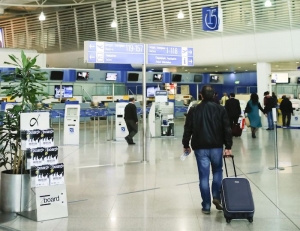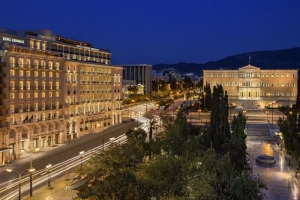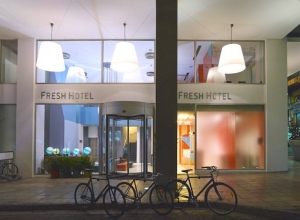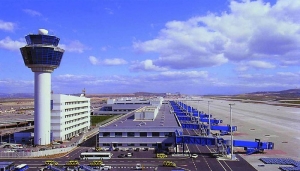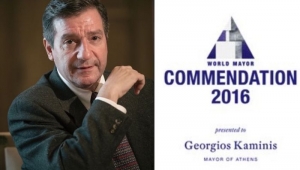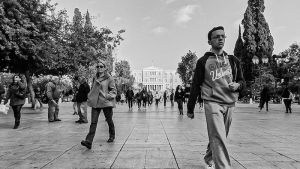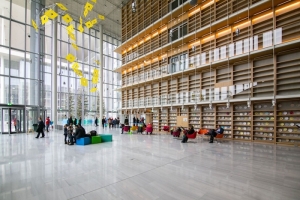BUSINESS CENTRE
XpatAthens
Tuesday, 24 January 2017 07:00
Athens Airport Ended 2016 With A Record 20.2 Million Passengers
Athens International Airport ended 2016 on a high note with a record 20.2 million passengers. Passenger numbers rose by a total of 10.7 percent (1.9 million) from the last year.
In December 2016 alone, the airport’s passengers reached 1.35 million, noting a 14.3 percent increase compared to prior-year levels. Domestic travellers rose by 8.3 percent, while international passengers grew strong at 18 percent. Moreover, Greek travellers increased by 19 percent and foreign visitors also presented growth at a 7 percent level.
To read this article in full, please visit: Greek Travel Pages
Published in
Local News
Tagged under
Thursday, 26 January 2017 07:00
Vote For Your Favourite 2017 European Destination
Athens made the list of candidates ~ Vote HERE from the 20th of January until the 10th of February!
For the eighth consecutive year you will be the ones to determine the ranking of the most trendy European destinations to visit in 2017. Your votes, coming from everywhere in the world, will be decisive during these three weeks of competition.
Which destination will be awarded the title of Best European destination of the year? We have pre-selected 20 incredible destinations that all deserve to win the prestigious title. Discover them and vote for your favourite!
Published in
Local News
Tagged under
Monday, 06 February 2017 07:00
Piraeus Aims To Highlight Ancient History Via Pedestrian Walkway
A pedestrian walkway across Zea Marina in Piraeus is set to offer archaeology lovers a seaside stroll through time as it aims to connect wall fortifications, towers and ancient harbor finds.
The Culture Ministry has tabled a plan which has already received the approval of the Central Archaeological Council to establish a historic route that will highlight the port city’s ancient history and landmarks.
The walkway, which will include the Hellenic Maritime Museum, will bring all the main sites, findings, buildings, cisterns and parts of the famous Kononeio Wall together through wooden ramps, bridges and constructions aiming to offer visitors insight into the port city’s vast history.
To read this article in full, please visit: Greek Travel Pages
Published in
Local News
Tagged under
Monday, 20 February 2017 07:00
Athens Prepares For Its 6th Half Marathon This March 2017
Athens will spring to life on March 19 when thousands of amateur and professional runners test their mettle at the 6th Athens Half Marathon, co-organized annually by the Hellenic Athletics Federation (SEGAS) and the City of Athens. Organizers are already expecting the numbers this year to break all records with registrations set to reach some 21,000.
Organized for the first time in 2012, organizers aim to turn the Athens Half Marathon into a global, unique sport cultural and entertaining running event and attract visitors from Europe and the rest of the world to participate and also experience Greece’s cuisine, sun, sea and the history and life of Athens.
All races start and finish in the heart of Athens, at Syntagma Square, in front of the Greek Parliament, running different courses in the historic city centre and passing by the main attractions. Runners can register online until March 3rd.
Please click HERE for more information.
To read this article in full, please visit: Greek Travel Pages
Published in
Local News
Tagged under
Tuesday, 28 February 2017 07:00
GB Roof Garden And Tudor Hall Win 2017 Golden Chef’s Hat Award
Award-winning Executive Chef Sotiris Evaggelou and his highly experienced team collected two Golden Chef’s Hat awards for the Hotel Grande Bretagne’s GB Roof Garden restaurant and the King George Hotel’s Tudor Hall restaurant.
The GB Roof Garden Restaurant, under the responsibility of Chef de Cuisine Asterios Koustoudis, received a Golden Chef’s Hat award for Modern International Cuisine.
The Tudor Hall restaurant, under the responsibility of Chef de Cuisine Alexandros Koskinas, scooped up a Golden Chef’s Hat award for its Greek Cuisine menu.
Since 1992, the Golden Chef’s Hat Awards are given to the best restaurants in Greece and organized by Athinorama magazine/city guide and Alpha Guide.
To read this article in full, please visit: Greek Travel Pages
Published in
Local News
Tagged under
Thursday, 02 March 2017 07:00
Hotel In Athens Is First To Receive Bike-Friendly Recognition
Fresh Hotel is the first Athens hotel to receive a special sticker indicating that it welcomes bicycle lovers and certifying that it has the facilities to accommodate their needs.
Fresh Hotel meets all six of the basic requirements including nine additional standards such as offering bicycle rentals options, working together with agents offering bike tours, providing bike racks, offering organic breakfast choices and rejuvenation and wellness options.
‘We welcome Fresh Hotel to the Bike Friendly Hotels family with great pleasure. It is the first hotel in Athens to receive certification, which is very hopeful for Athens’ tourism,' said Vicky Karantzavelou, PR manager NATTOUR.
To read this article in full, please visit: Greek Travel Pages
Published in
Local News
Tagged under
Monday, 06 March 2017 07:00
Athens Int'l Airport Becomes 25th European Airport To Be Carbon Neutral Certified
Athens International Airport, Eleftherios Venizelos, was recently certified by the independent carbon management program Airport Carbon Accreditation as being certified carbon neutral. This makes the airport the 25th certified carbon neutral airport in Europe.
Proud of Athens’ accomplishment is Dr Yiannis Paraschis, the CEO of Athens International Airport. He says, ‘By achieving carbon neutrality, Athens International Airport continues to tangibly demonstrate its commitment to the fight against climate change.’
To read this article in full, please visit: Greek Reporter
Published in
Local News
Tagged under
Tuesday, 07 March 2017 07:00
Mayors Of Athens And Lesvos Included In 2016 World Mayor Honours List
Athens Mayor Giorgos Kaminis and Lesvos Mayor Spiros Galinos are among the 10 most outstanding mayors in the world, according to the results of the biennial World Mayor competition announced recently by the organizer of the City Mayors Foundation.
Mayors Kaminis and Galinos stood out for welcoming refugees and offering them safety, shelter and support in their cities.
According to the World Mayor website, Athens, Lesvos and Lampedusa (Italy) are the three Mediterranean communities in the World Mayor Honours List that must receive special recognition for the welcome they offered to tens of thousands of men, women and children who were fleeing the fighting in the Middle East or poverty in Africa.
To read this article in full, please visit: Greek Travel Pages
Published in
Local News
Tagged under
Monday, 13 March 2017 07:52
New Residence Permits To Be Issued For Foreigners Living In Greece
Adhesive labels in passports and all other kinds of paperwork relating to foreign nationals living in Greece are to be scrapped and replaced by a new, electronic residence permit that will also double up as an identity card.
There are currently 557,476 third-country nationals living in Greece legally and they will soon be able to apply for a meeting with authorities to go through the necessary process for obtaining their permits.
Within 30 days of receiving the application, Greek authorities will have to set a date for the meeting, during which their biometric data (user’s photo and fingerprints) will be recorded so it can be entered on the card’s electronic chip. The chip can also store electronic proof of identity and a qualified electronic signature.
To read this article in full, please visit: Ekathimerini
Published in
Local News
Tagged under
Monday, 20 March 2017 08:02
The National Library Of Greece To Relocate
The National Library of Greece, under the direction of Dr. Filippos Tsimpoglou, General Director, is methodically preparing for a historic relocation that will enable its transition into a new digital era of innovation and extroversion. From the Vallianeio historic neoclassical building in the center of Athens, which together with the University of Athens and the Academy form the Athens Trilogy, the National Library is moving its headquarters to a state-of-the-art building erected by architect Renzo Piano for the Stavros Niarchos Foundation Cultural Center (SNFCC).
The entrance to the Library leads into a large open lobby that provides an immediate visual orientation to all the organization’s functions. The natural light creates an open hospitable environment for individual and collaborative learning. Within its new premises, the National Library of Greece will thus be able to strengthen its role in the field of Research, while expanding its focus from an exclusive research facility to an inclusive public resource, an active hub for knowledge, enterprise and innovation.
Starting from March 2017, the National Library of Greece has six months to complete the relocation process and two months to conduct pilot operation at the new building. Based on this framework, the library opening is being scheduled for Autumn 2017.
To read this article in full, please visit: Greek News Agenda
Photo Credit: Giorgis Gerolympos, Greek News Agenda
Photo Credit: Giorgis Gerolympos, Greek News Agenda
Published in
Local News
Tagged under


